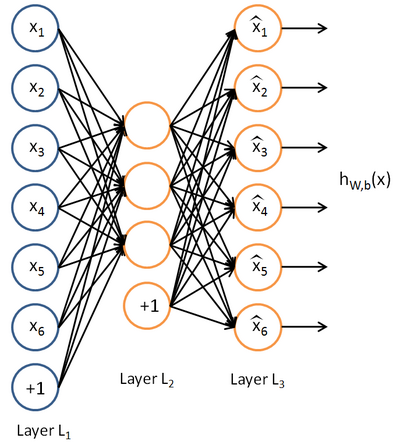Sparse Autoencoder(二)
Gradient checking and advanced optimization
In this section, we describe a method for numerically checking the derivatives computed by your code to make sure that your implementation is correct. Carrying out the derivative checking procedure described here will significantly increase your confidence in the correctness of your code.
Suppose we want to minimize
as a function of
. For this example, suppose
, so that
. In this 1-dimensional case, one iteration of gradient descent is given by
Suppose also that we have implemented some function
that purportedly computes
, so that we implement gradient descent using the update
.
Recall the mathematical definition of the derivative as
Thus, at any specific value of
, we can numerically approximate the derivative as follows:
Thus, given a function
that is supposedly computing
, we can now numerically verify its correctness by checking that
The degree to which these two values should approximate each other will depend on the details of
. But assuming
, you'll usually find that the left- and right-hand sides of the above will agree to at least 4 significant digits (and often many more).
Suppose we have a function
that purportedly computes
; we'd like to check if
is outputting correct derivative values. Let
, where
is the
-th basis vector (a vector of the same dimension as
, with a "1" in the
-th position and "0"s everywhere else). So,
is the same as
, except its
-th element has been incremented by EPSILON. Similarly, let
be the corresponding vector with the
-th element decreased by EPSILON. We can now numerically verify
's correctness by checking, for each
, that:
参数为向量,为了验证每一维的计算正确性,可以控制其他变量
When implementing backpropagation to train a neural network, in a correct implementation we will have that
This result shows that the final block of psuedo-code in Backpropagation Algorithm is indeed implementing gradient descent. To make sure your implementation of gradient descent is correct, it is usually very helpful to use the method described above to numerically compute the derivatives of
, and thereby verify that your computations of
and
are indeed giving the derivatives you want.
Autoencoders and Sparsity
Anautoencoder neural network is an unsupervised learning algorithm that applies backpropagation, setting the target values to be equal to the inputs. I.e., it uses
.
Here is an autoencoder:
we will write
to denote the activation of this hidden unit when the network is given a specific input
. Further, let
be the average activation of hidden unit
(averaged over the training set). We would like to (approximately) enforce the constraint
where
is a sparsity parameter, typically a small value close to zero (say
). In other words, we would like the average activation of each hidden neuron
to be close to 0.05 (say). To satisfy this constraint, the hidden unit's activations must mostly be near 0.
To achieve this, we will add an extra penalty term to our optimization objective that penalizes
deviating significantly from
. Many choices of the penalty term will give reasonable results. We will choose the following:
Here,
is the number of neurons in the hidden layer, and the index
is summing over the hidden units in our network. If you are familiar with the concept of KL divergence, this penalty term is based on it, and can also be written
Our overall cost function is now
where
is as defined previously, and
controls the weight of the sparsity penalty term. The term
(implicitly) depends on
also, because it is the average activation of hidden unit
, and the activation of a hidden unit depends on the parameters
.
Visualizing a Trained Autoencoder
Consider the case of training an autoencoder on
images, so that
. Each hidden unit
computes a function of the input:
We will visualize the function computed by hidden unit
---which depends on the parameters
(ignoring the bias term for now)---using a 2D image. In particular, we think of
as some non-linear feature of the input
If we suppose that the input is norm constrained by
, then one can show (try doing this yourself) that the input which maximally activates hidden unit
is given by setting pixel
(for all 100 pixels,
) to
By displaying the image formed by these pixel intensity values, we can begin to understand what feature hidden unit
is looking for.
对一幅图像进行Autoencoder ,前面的隐藏结点一般捕获的是边缘等初级特征,越靠后隐藏结点捕获的特征语义更深。
Sparse Autoencoder(二)的更多相关文章
- DL二(稀疏自编码器 Sparse Autoencoder)
稀疏自编码器 Sparse Autoencoder 一神经网络(Neural Networks) 1.1 基本术语 神经网络(neural networks) 激活函数(activation func ...
- Deep Learning 1_深度学习UFLDL教程:Sparse Autoencoder练习(斯坦福大学深度学习教程)
1前言 本人写技术博客的目的,其实是感觉好多东西,很长一段时间不动就会忘记了,为了加深学习记忆以及方便以后可能忘记后能很快回忆起自己曾经学过的东西. 首先,在网上找了一些资料,看见介绍说UFLDL很不 ...
- (六)6.5 Neurons Networks Implements of Sparse Autoencoder
一大波matlab代码正在靠近.- -! sparse autoencoder的一个实例练习,这个例子所要实现的内容大概如下:从给定的很多张自然图片中截取出大小为8*8的小patches图片共1000 ...
- UFLDL实验报告2:Sparse Autoencoder
Sparse Autoencoder稀疏自编码器实验报告 1.Sparse Autoencoder稀疏自编码器实验描述 自编码神经网络是一种无监督学习算法,它使用了反向传播算法,并让目标值等于输入值, ...
- 七、Sparse Autoencoder介绍
目前为止,我们已经讨论了神经网络在有监督学习中的应用.在有监督学习中,训练样本是有类别标签的.现在假设我们只有一个没有带类别标签的训练样本集合 ,其中 .自编码神经网络是一种无监督学习算法,它使用 ...
- CS229 6.5 Neurons Networks Implements of Sparse Autoencoder
sparse autoencoder的一个实例练习,这个例子所要实现的内容大概如下:从给定的很多张自然图片中截取出大小为8*8的小patches图片共10000张,现在需要用sparse autoen ...
- 【DeepLearning】Exercise:Sparse Autoencoder
Exercise:Sparse Autoencoder 习题的链接:Exercise:Sparse Autoencoder 注意点: 1.训练样本像素值需要归一化. 因为输出层的激活函数是logist ...
- Sparse AutoEncoder简介
1. AutoEncoder AutoEncoder是一种特殊的三层神经网络, 其输出等于输入:\(y^{(i)}=x^{(i)}\), 如下图所示: 亦即AutoEncoder想学到的函数为\(f_ ...
- Exercise:Sparse Autoencoder
斯坦福deep learning教程中的自稀疏编码器的练习,主要是参考了 http://www.cnblogs.com/tornadomeet/archive/2013/03/20/2970724 ...
随机推荐
- bzoj1457: 棋盘游戏 SG函数 Nim
Code: #include<cstdio> #include<cstring> using namespace std; #define maxn 1003 #define ...
- Ubuntu(kali)开启mysql远程连接
Linux 默认关闭mysql的远程连接,编辑 /etc/mysql/my.cnf 文件, 把里面的 bind-address = 127.0.0.1 改成 bind-address = 0.0.0. ...
- NodeJS学习笔记 (17)集群-cluster(ok)
cluster模块概览 node实例是单线程作业的.在服务端编程中,通常会创建多个node实例来处理客户端的请求,以此提升系统的吞吐率.对这样多个node实例,我们称之为cluster(集群). 借助 ...
- node使用express命令报错找不到ejs的解决方法
首先确定已经全局安装过好几遍express和express-generator,但一使用express命令直接报找不到ejs模块,全局和本地安装ejs都没用,nodemon模块报同样错误,找不到deb ...
- scrapy xpath选择器多级选择错误
在学习scrapy中用xpath提取网页内容时,有时要先提取出一整个行标签内容,再从行标签里寻找目标内容.出现一个错误. 错误代码: def parse(self, response): sel = ...
- P4555 [国家集训队]最长双回文串(回文树)
题目描述 顺序和逆序读起来完全一样的串叫做回文串.比如acbca是回文串,而abc不是(abc的顺序为abc,逆序为cba,不相同). 输入长度为 n 的串 S ,求 S 的最长双回文子串 T ,即可 ...
- 01-JS起步
01-JS起步
- 无比强大!Python抓取cssmoban网站的模版并下载
Python实现抓取http://www.cssmoban.com/cssthemes网站的模版并下载 实现代码 # -*- coding: utf-8 -*- import urlparse imp ...
- Android笔记---Intent实现Activity跳转
学了之前的Android控件以及布局,我们就能够做一些UI的设计了,这里我结合之前的知识.以一个小的登录项目来解说下Activity之间跳转. 先看下效果图: 1.登录界面: 2.点击登录按钮跳转到另 ...
- Oracle EBS发放销售订单
模拟发放销售订单界面进行发放操作 PROCEDURE insert_row(x_batch_id OUT NUMBER) IS l_autopack_flag VARCHAR2(1 ); l_a ...
















